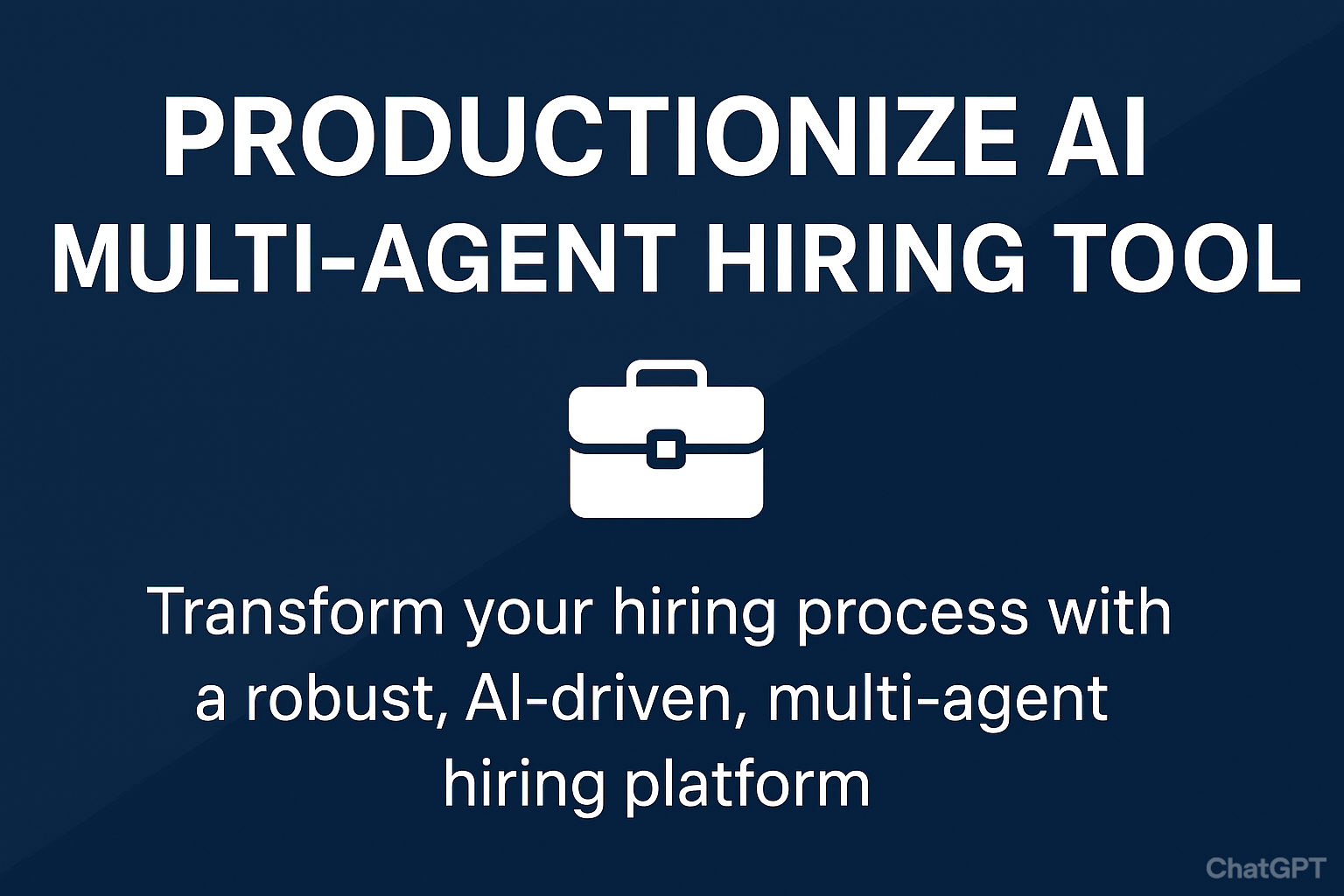
Hiring teams often find themselves buried under mountains of résumés—scrolling endlessly, filtering tirelessly, and still wondering if they’ve missed the right candidate. The process is slow, repetitive, and often clouded by bias. We witnessed this struggle firsthand and asked a simple question: What if AI could handle the tedious tasks, allowing recruiters to focus on what truly matters—people?
That question sparked the creation of our AI Multi-Agent Hiring Orchestrator, a system where intelligent agents collaborate to read, understand, and rank résumés with human-like precision. The full story of that orchestration, how each agent works together to streamline hiring, is shared in our earlier publication, https://app.readytensor.ai/publications/ai-multi-agent-hiring-orchestrator-m6Fw76jO7ROe
But innovation doesn’t stop at intelligence—it needs reliability. This next chapter, The AI Stack on Render, tells the story of how that orchestration comes to life in production. It’s about bridging ideas with execution—deploying, testing, and safeguarding the system in a real-world environment. From automated builds to smart fallbacks and guardian layers, this phase ensures the AI-powered hiring platform isn’t just brilliant in concept, but dependable in operation.
This publication highlights the key components for a production-ready AI recruitment system: Testing with unit, integration, and end-to-end coverage; Safety & Security via input validation, output filtering, and error handling; User Interface through a simple, interactive web app; Resilience & Monitoring using retries, timeouts, and logging; and Documentation covering deployment, architecture, APIs, and troubleshooting—ensuring the system is reliable, safe, and easy to maintain.
To ensure the AI recruitment system operates reliably in production, we implemented a structured, multi-layered testing strategy. The methodology covers health checks, resource creation, AI integration, end-to-end workflow validation, performance monitoring, and robust logging for traceability.
The backend API is first verified for availability using a simple GET request to the /api/status/ endpoint. Successful execution returns an HTTP 200 response, confirming the system is online and ready for functional testing.
# Load environment variables (for local testing) load_dotenv() BASE_URL = os.getenv("RENDER_BACKEND_URL", "https://hr-recruitment-backend.onrender.com") def test_1_health_check(): """Test the basic health of the Django API.""" print(f"\n--- 1. Testing Health Check: {BASE_URL} ---") try: response = requests.get(f"{BASE_URL}/api/status/") assert response.status_code == 200 print("PASS: Health check successful.") except Exception as e: print(f"FAIL: Health check failed. Error: {e}") test_1_health_check()
Essential resources such as job postings are created to enable downstream workflow testing. The API returns the resource ID upon successful creation.
TEST_JOB_TITLE = "Senior Python Developer" def test_2_create_job_posting(): """Test creating a required resource (Job Posting) for later tests.""" print("\n--- 2. Testing Job Posting Creation ---") endpoint = f"{BASE_URL}/api/jobs/" data = { "title": TEST_JOB_TITLE, "description": "Django, API, Python expertise required.", "requirements": "3+ years Python/Django experience." } response = requests.post(endpoint, json=data) if response.status_code == 201: job_id = response.json().get('id') print(f"PASS: Job created successfully. ID: {job_id}") return job_id else: print(f"FAIL: Job creation failed. Status: {response.status_code}, Response: {response.text}") return None job_id = test_2_create_job_posting()
The system’s core functionality—AI résumé screening—is validated by uploading a test résumé and calling the Hugging Face AI service. Response fields like score and summary are checked for correctness.
TEST_RESUME_PATH = "test_resume.pdf" def test_3_ai_screening_integration(job_id): """Test the core logic: uploading a resume and triggering AI screening.""" if not job_id: print("SKIP: AI test skipped because Job ID is missing.") return print("\n--- 3. Testing AI Screening Integration ---") endpoint = f"{BASE_URL}/api/candidates/screen/" try: with open(TEST_RESUME_PATH, 'rb') as f: files = {'resume_file': (os.path.basename(TEST_RESUME_PATH), f, 'application/pdf')} data = {'job_id': job_id} response = requests.post(endpoint, files=files, data=data, timeout=30) if response.status_code in [200, 201]: result = response.json() if 'score' in result and 'summary' in result: print(f"PASS: AI Screening successful. Score: {result.get('score')}") print(f"AI Summary Snippet: {result.get('summary')[:50]}...") else: print(f"FAIL: AI Screening succeeded, but unexpected response format: {result}") else: print(f"FAIL: AI Screening API failed. Status: {response.status_code}, Response: {response.text}") except FileNotFoundError: print(f"FATAL: Test file not found at {TEST_RESUME_PATH}") except requests.exceptions.Timeout: print("FAIL: AI Screening timed out. Hugging Face Space may be slow to wake up.") except Exception as e: print(f"FAIL: An unexpected error occurred during AI test: {e}") test_3_ai_screening_integration(job_id)
The full workflow—from React frontend through Django backend, PostgreSQL database, and AI service—is simulated using automated tools like Playwright or Cypress to ensure seamless operation.
Render’s metrics dashboard tracks AI response times, system resource usage, and autoscaling events. Detailed logging captures failures, retries, and fallback events to guarantee traceability and graceful degradation under load.
Through this approach, each layer of the stack—React, Django, and Hugging Face AI—is validated, ensuring a robust, production-ready deployment.
The AI recruitment platform is deployed using Render, which simplifies hosting for complex stacks by allowing each component to run independently with secure internal networking. The system is composed of four main components: Frontend, Backend, Database, and AI Service.
| Component | Render Service Type | Role | Key Feature |
|---|---|---|---|
| Frontend | Static Site | Serves the React application globally | Fast CDN delivery, Free Tier eligible |
| Backend (API) | Web Service | Handles API requests, database operations, and AI calls | Auto-scaling, zero-downtime via Gunicorn |
| Database | PostgreSQL | Stores all application data | Internal networking, secure link to Backend |
| AI Component | Web Service (Gradio/FastAPI) | Processes AI requests | Separate scaling for compute-intensive tasks |
Key Deployment Links:
Hugging Face AI Model:https://addisut-ai-powered-hr-requirement-ai-agent.hf.space/run/screen
HR Recruitment Portal (Frontend + Backend): https://hr-recruitment-frontend.onrender.com/
flowchart LR Browser["Browser (User UI)"] Frontend["Frontend (React App, CDN)"] Backend["Backend (Django API)"] Database["PostgreSQL Database"] AI["AI Service (Gradio/FastAPI)"] Browser --> Frontend Frontend --> Backend["HTTPS API Calls"] Backend --> Database["Internal Network"] Backend --> AI["Internal Request"]
All services and environment variables are defined in render.yaml (Configuration as Code).
Integration with GitHub enables automatic builds: